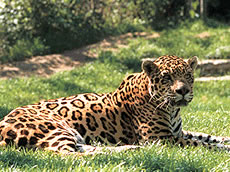Jaguar
 The
jaguar (Panthera onca) is a big cat, a feline in the Panthera genus,
and is the only Panthera species found in the Americas. The jaguar
is the third-largest feline after the tiger and the lion, and the
largest in the Western Hemisphere. The jaguar's present range
extends from Mexico across much of Central America and south to
Paraguay and northern Argentina. Apart from a known and possibly
breeding population in Arizona (southeast of Tucson), the cat has
largely been extirpated from the United States since the early
1900s.
The
jaguar (Panthera onca) is a big cat, a feline in the Panthera genus,
and is the only Panthera species found in the Americas. The jaguar
is the third-largest feline after the tiger and the lion, and the
largest in the Western Hemisphere. The jaguar's present range
extends from Mexico across much of Central America and south to
Paraguay and northern Argentina. Apart from a known and possibly
breeding population in Arizona (southeast of Tucson), the cat has
largely been extirpated from the United States since the early
1900s.
This spotted cat most closely resembles the leopard physically,
although it is usually larger and of sturdier build and its
behavioral and habitat characteristics are closer to those of the
tiger. While dense rainforest is its preferred habitat, the jaguar
will range across a variety of forested and open terrain. It is
strongly associated with the presence of water and is notable, along
with the tiger, as a feline that enjoys swimming. The jaguar is a
largely solitary, stalk-and-ambush predator, and is opportunistic in
prey selection. It is also an apex and keystone predator, playing an
important role in stabilizing ecosystems and regulating the
populations of prey species. The jaguar has an exceptionally
powerful bite, even relative to the other big cats. This allows it
to pierce the shells of armoured reptiles and to employ an unusual
killing method: it bites directly through the skull of prey between
the ears to deliver a fatal bite to the brain.
The jaguar is a near threatened species and its numbers are
declining. Threats include habitat loss and fragmentation. While
international trade in jaguars or their parts is prohibited, the cat
is still regularly killed by humans, particularly in conflicts with
ranchers and farmers in South America. Although reduced, its range
remains large; given its historical distribution, the jaguar has
featured prominently in the mythology of numerous indigenous
American cultures, including that of the Maya and Aztec.
Video
